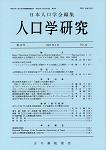Volume 37
Displaying 1-31 of 31 articles from this issue
- |<
- <
- 1
- >
- >|
Index
-
Article type: Cover
2005 Volume 37 Pages Cover1-
Published: November 30, 2005
Released on J-STAGE: September 12, 2017
Download PDF (183K) -
Article type: Index
2005 Volume 37 Pages Toc1-
Published: November 30, 2005
Released on J-STAGE: September 12, 2017
Download PDF (183K) -
Article type: Appendix
2005 Volume 37 Pages App1-
Published: November 30, 2005
Released on J-STAGE: September 12, 2017
Download PDF (162K)
Presidential Address
-
Article type: Article
2005 Volume 37 Pages 1-9
Published: November 30, 2005
Released on J-STAGE: September 12, 2017
Download PDF (360K)
Article
-
Article type: Article
2005 Volume 37 Pages 11-30
Published: November 30, 2005
Released on J-STAGE: September 12, 2017
Download PDF (288K) -
Article type: Article
2005 Volume 37 Pages 31-46
Published: November 30, 2005
Released on J-STAGE: September 12, 2017
Download PDF (381K) -
Article type: Article
2005 Volume 37 Pages 47-65
Published: November 30, 2005
Released on J-STAGE: September 12, 2017
Download PDF (431K) -
Article type: Article
2005 Volume 37 Pages 67-82
Published: November 30, 2005
Released on J-STAGE: September 12, 2017
Download PDF (691K)
Note
-
Article type: Article
2005 Volume 37 Pages 83-94
Published: November 30, 2005
Released on J-STAGE: September 12, 2017
Download PDF (390K)
Scientific Information
-
Article type: Article
2005 Volume 37 Pages 95-96
Published: November 30, 2005
Released on J-STAGE: September 12, 2017
Download PDF (183K) -
Article type: Article
2005 Volume 37 Pages 97-100
Published: November 30, 2005
Released on J-STAGE: September 12, 2017
Download PDF (179K)
Book Reviews
-
Article type: Article
2005 Volume 37 Pages 101-103
Published: November 30, 2005
Released on J-STAGE: September 12, 2017
Download PDF (156K) -
Article type: Article
2005 Volume 37 Pages 104-106
Published: November 30, 2005
Released on J-STAGE: September 12, 2017
Download PDF (232K) -
Article type: Article
2005 Volume 37 Pages 107-109
Published: November 30, 2005
Released on J-STAGE: September 12, 2017
Download PDF (226K) -
Article type: Article
2005 Volume 37 Pages 110-111
Published: November 30, 2005
Released on J-STAGE: September 12, 2017
Download PDF (331K) -
Article type: Article
2005 Volume 37 Pages 111-112
Published: November 30, 2005
Released on J-STAGE: September 12, 2017
Download PDF (331K) -
Article type: Article
2005 Volume 37 Pages 112-113
Published: November 30, 2005
Released on J-STAGE: September 12, 2017
Download PDF (332K) -
Article type: Article
2005 Volume 37 Pages 113-114
Published: November 30, 2005
Released on J-STAGE: September 12, 2017
Download PDF (331K) -
Article type: Appendix
2005 Volume 37 Pages 115-
Published: November 30, 2005
Released on J-STAGE: September 12, 2017
Download PDF (149K)
PAJ Information
-
Article type: Appendix
2005 Volume 37 Pages 116-119
Published: November 30, 2005
Released on J-STAGE: September 12, 2017
Download PDF (297K) -
Article type: Appendix
2005 Volume 37 Pages 120-125
Published: November 30, 2005
Released on J-STAGE: September 12, 2017
Download PDF (328K) -
Article type: Appendix
2005 Volume 37 Pages 126-128
Published: November 30, 2005
Released on J-STAGE: September 12, 2017
Download PDF (250K) -
Article type: Appendix
2005 Volume 37 Pages 128-
Published: November 30, 2005
Released on J-STAGE: September 12, 2017
Download PDF (234K) -
Article type: Appendix
2005 Volume 37 Pages 129-130
Published: November 30, 2005
Released on J-STAGE: September 12, 2017
Download PDF (131K) -
Article type: Appendix
2005 Volume 37 Pages 131-
Published: November 30, 2005
Released on J-STAGE: September 12, 2017
Download PDF (81K) -
Article type: Appendix
2005 Volume 37 Pages 132-133
Published: November 30, 2005
Released on J-STAGE: September 12, 2017
Download PDF (135K) -
Article type: Appendix
2005 Volume 37 Pages 134-
Published: November 30, 2005
Released on J-STAGE: September 12, 2017
Download PDF (64K) -
Article type: Appendix
2005 Volume 37 Pages 134-
Published: November 30, 2005
Released on J-STAGE: September 12, 2017
Download PDF (64K) -
Article type: Appendix
2005 Volume 37 Pages App2-
Published: November 30, 2005
Released on J-STAGE: September 12, 2017
Download PDF (162K) -
Article type: Cover
2005 Volume 37 Pages Cover2-
Published: November 30, 2005
Released on J-STAGE: September 12, 2017
Download PDF (178K) -
Article type: Index
2005 Volume 37 Pages Toc2-
Published: November 30, 2005
Released on J-STAGE: September 12, 2017
Download PDF (178K)
- |<
- <
- 1
- >
- >|
